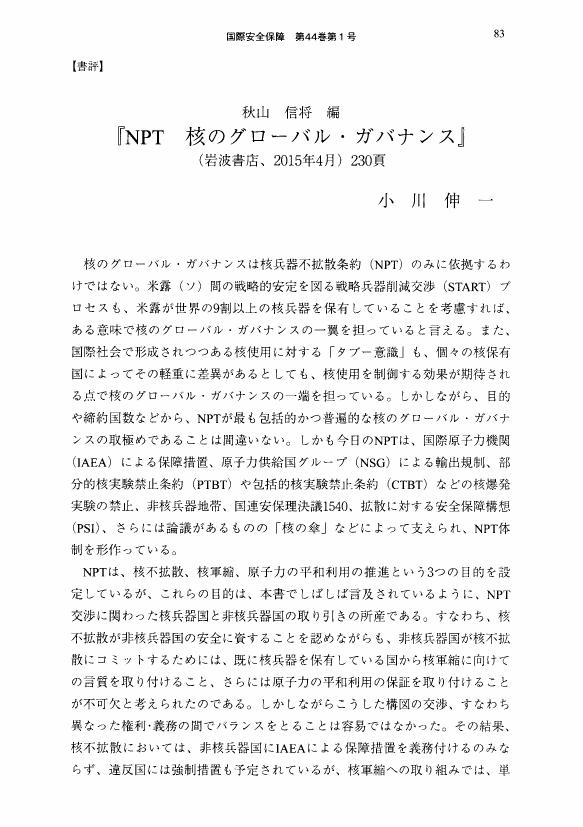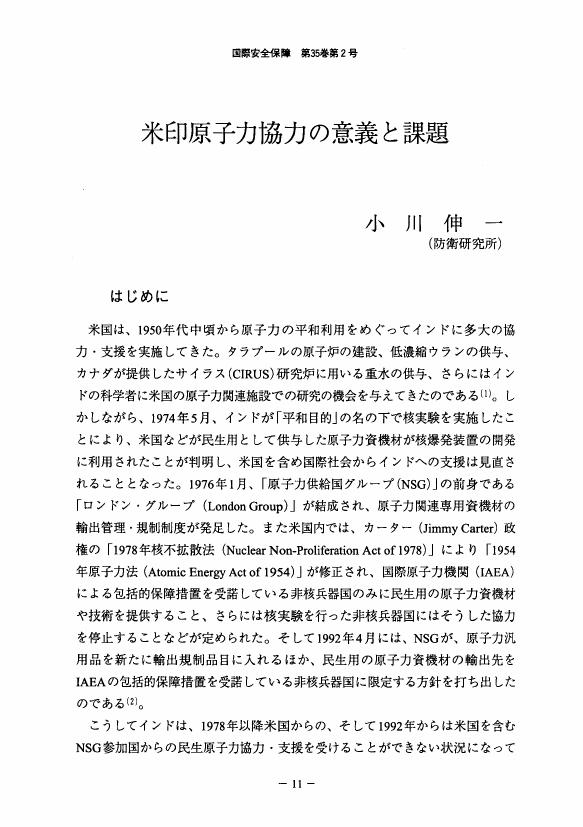4 0 0 0 OA 制度としての文化財 明治期における〈国宝〉の誕生と宗教・美術の問題
- 著者
- 小川 伸彦
- 出版者
- 社会学研究会
- 雑誌
- ソシオロジ (ISSN:05841380)
- 巻号頁・発行日
- vol.35, no.3, pp.109-129,182, 1991-02-28 (Released:2017-02-15)
- 被引用文献数
- 1
Every object acquires its social significance by being multiply defined from various domains of values, such as the political, the economic, the historical, the aesthetic, the religious and so on. The definition of Cultural Property in Japan (Bunkazai) is one of such domains. If something is registered as an Important Cultural Property, this signifies not only its historical and artistic importance, but means also that the thing has been introduced into a new value domain. However, when an object with religious value is registered to be a cultural property, its two definitions ('religious' and 'cultural') from the different value domains are not always compatible. This is so, because its definition as a cultural property, being institutionalized and authorized by the state and supported widely by the people, easily overwhelms its religious definition. The purpose of this paper is to doubt sociologically, with the help of historical facts and documents, the taken-for-grantedness of the value domain called "Cultural Property". It was in 1897 that the definition "National Treasure", the highest category of Cultural Property, was newly introduced by the Old Shrines and Temples Preservation Act. And it was this act that served as the basis for the present Cultural Properties Protection Act enacted in 1950. After analyzing 1) how the conception of "fine art" was interpreted in Japan over a thirty year period, from the Meiji Restoration in 1868 until 1897, 2) why things with religious value became the objects of preservation, and 3) what kind of discussion was held in the Imperial Diet in approving the act, one conclusion seems clear. That is, that the value "National Treasure" was brought forth in order to meet two demands: the spiritual demand which was enhanced by the nationalistic trend of the time and the demand for the promotion of overseas trade to increase the national wealth. The birth of the National Treasure can be interpreted, from one side, as a symbolic example of the secularization of religion during the modernization process of Meiji Japan. But from the other side, it was a conversion of a religious symbol into a national symbol which was none the less sacred.
3 0 0 0 OA 化学名における「化」の意味について
- 著者
- 小川 伸
- 出版者
- 一般社団法人 日本ゴム協会
- 雑誌
- 日本ゴム協会誌 (ISSN:0029022X)
- 巻号頁・発行日
- vol.69, no.6, pp.414-415, 1996 (Released:2007-07-09)
2 0 0 0 記憶と文化-「赤穂事件」記憶への文化社会学的アプローチ-
本研究の目的は、記憶と文化の関係について18世紀初頭の「赤穂事件」を手掛かりに分析し「文化社会学」の理論的・経験的な可能性を追究するものである。この場合、(1)記憶は既存の文化的な「枠」に準拠して「構成/再構成」される、(2)記憶は集団や個人のアイデンティティ形成の焦点となり、新たな「文化」や「物語」として「生成」する、という仮設を設けた。研究の結果、次の知見等が得られた。1.文化論・記憶関係の諸議論を検討し、記憶と文化の関係の二重性や記憶様態の類型を理論的に明確にした。2.『假名手本忠臣蔵』の英仏訳書や忠臣蔵論等を検討し、赤穂事件記憶の演劇文化や国民文化としての成立過程の一側面について知見を得た。3.『忠臣蔵』の歌舞伎上演記録から、明治末から大正にかけての上演数の突出を確認し、これがナショナリズムの高揚と結びつく国民文化の形成に関連すると指摘した。4.事件記憶の構成において「サムライ名誉文化」がどの程度「枠」として機能したのかについて、事件論評や武士(道)関連文献を検討し理論的な知見を得た。5.「赤穂義士祭」について、義士祭・義士会および観光関係の資料を収集し義士祭の担い手やツーリズム的特性について知見を得た。6.愛知県吉良町における吉良義央関係の史跡・事績・伝承等を整理し、「対抗記憶」が形成されてきたことを確認した。7.京都・山科の岩屋寺における拝観者への対応に関する調査により、事件に関する語りを採取し分析した。8.長野南部伝承の義士踊りを現地調査し歴史的事件の芸能化に関する知見を得た。9.「銚子塚」(川崎)、「泉岳寺」(東京)、「大石神社」(京都)の調査結果を比較しつつ、義士記憶にまつわる祭祀のあり方を分析した。10.「忠臣蔵サミット」関係の資料を分析し、事件記憶の行政文化的・地域文化的な資源=資本化の動態について知見を得た。以上の調査研究から記憶と文化の関係の二重性仮説をある程度検証することができた。
- 著者
- 小川 伸彦
- 出版者
- 日仏社会学会
- 雑誌
- 日仏社会学会年報 (ISSN:13437313)
- 巻号頁・発行日
- vol.22, pp.105-119, 2012-03-31 (Released:2017-06-09)
1 0 0 0 OA 秋山 信将 編『NPT 核のグローバル・ガバナンス』
- 著者
- 小川 伸一
- 出版者
- 国際安全保障学会
- 雑誌
- 国際安全保障 (ISSN:13467573)
- 巻号頁・発行日
- vol.44, no.1, pp.83-87, 2016-06-30 (Released:2022-04-01)
1 0 0 0 OA 米印原子力協力の意義と課題
- 著者
- 小川 伸一
- 出版者
- 国際安全保障学会
- 雑誌
- 国際安全保障 (ISSN:13467573)
- 巻号頁・発行日
- vol.35, no.2, pp.11-33, 2007-09-30 (Released:2022-04-20)
- 著者
- 小川 伸彦
- 出版者
- 奈良女子大学文学部
- 雑誌
- 奈良女子大学文学部研究教育年報 (ISSN:13499882)
- 巻号頁・発行日
- no.10, pp.15-32, 2013
- 著者
- 原田 和樹 小泉 武夫 永塚 規衣 長尾 慶子 數村 公子 前田 俊道 徳永 拓史 長谷川 喜朗 小川 伸也 岡村 英子 河村 幸恵 小俣 文登 金谷 節子
- 出版者
- 日本調理科学会
- 雑誌
- 日本調理科学会大会研究発表要旨集
- 巻号頁・発行日
- vol.21, pp.1089, 2009
<BR>【目的】我々は、咀嚼嚥下障害者食の抗酸化性について長年研究し、本学会で報告してきた。今回は、水産物由来で未利用資源であるナルトビエイに着目し、咀嚼嚥下障害者食を想定して調製した調理加工品が持つ抗酸化性を、多視点解析で行った結果を報告する。<BR>【方法】試料の形態は、煮こごり、魚醤、天日干し調味液漬けとし、試料が持つ抗酸化能の多視点解析は、ケミルミネッセンス(化学発光)法、電子スピン共鳴(ESR)法、米国農務省推奨のORAC法並びにHORAC法、また、好中球様分化細胞HL60の細胞内Caイオン濃度変化と活性酸素産生を蛍光・化学発光で同時に検出した結果から、シグナルトランスダクション経路をもとに作用機序の解析が可能である新しい次世代食品機能性評価法も用いた<SUP>1)</SUP>。それぞれの方法では、ペルオキシラジカル、ヒドロキシルラジカル、スーパーオキシドアニオン・ラジカルの消去活性能などを解析する事になる。<BR>【結果】ナルトビエイの煮こごり試料では、生肉と比較して、ORAC法では5.7倍、ESR法では6.7倍、抗酸化性が増大した。一方、ナルトビエイの肉を調味料の魚醤にすると、ORAC値の平均は、7271µmol TE/100mlとなり、HORAC値の平均は、42981µmol GAE/100mlとなった。なお、その時のESR法でのIC<SUB>50</SUB>値は平均0.08%であった。なお、次世代食品機能性評価法においては、従来知見を得ている単一成分の試料に対してばかりでなく、複合成分で構成されたこれら咀嚼嚥下障害者食材でも、解析が可能である事を見出した。<BR>1) 數村公子, 原田和樹, 前田俊道, 徳永拓史, 土屋広司: 日本食品科学工学会第56回大会講演集, 印刷中 (2009).
1 0 0 0 OA 磁性流体の磁気複屈折と二色性
- 著者
- 武富 荒 小川 伸一 宮島 英紀 近角 聡信
- 出版者
- 公益社団法人 日本磁気学会
- 雑誌
- 日本応用磁気学会誌 (ISSN:02850192)
- 巻号頁・発行日
- vol.12, no.2, pp.263-268, 1988-04-30 (Released:2007-12-07)
- 参考文献数
- 20
- 被引用文献数
- 14 16
Magnetooptical effect of magnetic fluids is investigated. The phase difference θ between the ordinary ray and the extraordinary ray which are transmitted through the magnetic fluid thin film was found to be described in the functional form θ1f(H)/[T-T1+f(H)], where H is the magnetic field applied to the magnetic fluid thin film, T is the absolute temperature of the film, f(H) is a certain increasing function of H and T1, θ1 are the positive constants. The field dependence of light transmissivity of magnetic fluid thin films is well described by the cluster model of ferrous colloidal particles in the applied field direction when the aggregation is small. The field dependence of transmissivity is, however, interpreted neither by the electric absorption of the clusters nor by the Rayleigh scattering when the cluster becomes larger. The diffraction effect by the linear clusters directed to the applied field must be taken into account in interpreting the light extinction.
1 0 0 0 OA ミサイル防衛の戦略的意義と国際安全保障に与える影響
- 著者
- 小川 伸子
- 出版者
- 美学会
- 雑誌
- 美学 (ISSN:05200962)
- 巻号頁・発行日
- vol.45, no.3, pp.23-33, 1994
Dieser Aufsatz versucht den Terminus 'Ironie' Friedrich Schlegels auf einen klaren Begriff zu bringen. Die eigene Problematik, die die Ironie enthalt, scheint aus seinen Betrachtungen uber den Wesenszug der modernen Poesie zu entstehen, den er mit Berufung der Fichteschen Philosophie begrundet. Der Wesenszug ist namlich die Reflexion. Die Ironie ist eine 'poetische Reflexion' d.h. die durch steten Wechsel von 'Selbstschopfung und Selbstvernichtung' sich fortzeugende Bewegung. Mit dieser Formulierung ubertragt er die dynamische aber abstrakte Bestimmung des transzendentalen Ich Fichtes auf konkrete Tatigkeiten des Kunstlers, der ein Kunstwerk als ein eine 'innere Einheit' erhaltendes Ganzes bildet. Seine Welt-Philosophie, die Fichtes Bewusstseinsphilosophie ontologisch konkretisiert, betrachtet die Welt als ein nie vollendbar, unendlich werdendes Ich. Die unendliche 'Realitat' der Welt, die fur Schlegel die 'Bedeutung' des Ganzen ist, kann mit einem abgeschlossenen System nie aufgefasst werden ; sie kann durch die Kunst nur geahnt werden. Die innere Einheit des Werkes wird dadurch ermoglicht, dass die Ironie uber einzelne Darstellungen und endliche Illusionen hinausgeht und diese zu dem Mittelpunkt des Werkes d.h. der Ahnung der unendlichen Bedeutung des Ganzen fuhrt. Dabei betrachtet er Goethes "Meister" als eine Realisierung solcher Ironie.
1 0 0 0 IR 表象される奈良 : B面の「なら学」のために
- 著者
- 小川 伸彦
- 出版者
- 奈良女子大学
- 雑誌
- 奈良女子大学文学部研究教育年報 (ISSN:13499882)
- 巻号頁・発行日
- vol.3, pp.27-37, 2007-03-31
1 0 0 0 IR 事件・シンボル・制度 : 法隆寺金堂壁画焼損と「文化財」の文化社会学
- 著者
- 小川 伸彦
- 出版者
- 奈良女子大学
- 雑誌
- 奈良女子大学社会学論集 (ISSN:13404032)
- 巻号頁・発行日
- vol.12, pp.115-138, 2005-03-01
Clarification of the sociological of the connection between a disastrous event and the invention of a new institution, that is, between the loss of the ancient wall paintings of Horyji-temple by fire in 1949 and the enactment of the Law for the Protection of Cultural Properties in 1950
- 著者
- 小川 伸介
- 出版者
- 思想の科学社
- 雑誌
- 思想の科学 第7次 (ISSN:03898083)
- 巻号頁・発行日
- no.44, pp.p22-47, 1984-02
- 著者
- 荻野 昌弘 小川 伸彦 脇田 健一 SEGURET Fran ABELES Marc JEUPY Henriー SEQURET Fron JEUDY Henri・
- 出版者
- 関西学院大学
- 雑誌
- 基盤研究(A)
- 巻号頁・発行日
- 1997
本研究は、日本で近年高まりつつある文化財・博物館の社会的意味を問うことをめざして行った。三年間にわたる日本と欧米、特にフランスの調査に基づく。そのなかで得られた知見は多岐にわたるが、まず、ふれられなければならないのは、フランスと日本では、文化財という用語の定義自体がまったく異なるという点である。フランスで用いられるpatrimoineという用語は、社会のなかで見捨てられていたものを見直し、公共の財産として保存していこうとする意志が含意されている。遺産を通じて社会(とその歴史)を常に見直していこうというその性格から、フランスにおける文化財制度が、文化財保存のためだけではなく、フランス社会の秩序を維持する中核的な役割を担っていることがわかる。これに対して、日本では、「文化財」という言葉が用いられるとき、「見捨てられていたもの」の再評価と公共財化という観点は欠けている。そもそも日本では、伝統はモノの保存を通じてではなく、かつてあったはずのものを「かたち」に表すことで維持される(これを現在化の論理と呼ぶ)。したがって、モノ自体を保存することに関してはそれほど関心が高かったわけではなく、博物館制度の本格的な定着が遅れたのも、博物館を生みだした西欧近代の博物学的欲望を共有しなかったからなのである。ところで、戦後日本で、ようやくモノを通じた保存が本格的に論じられるようになったきっかけのひとつに、負の遺産と呼ばれる戦争遺産の保存問題がある(なお、負の遺産には公害、原子力事故の遺産なども含まれる)。それは、他の遺産とは異なり、展示品や展示方法に関してさまざまな議論を呼ぶ。研究者も例外ではなく、戦争遺産遺産に関しては、多様な解釈が可能である。本研究では、「視点の複合性」という立場にたち、ある特定の解釈だけを選択せず、多様な視点をいわば「共存」させる方法をとっている点が、方法論のうえでの新たな点である。
1 0 0 0 OA 原発不明肺門リンパ節癌切除後に原発巣と考えられる肺腫瘍を切除した1例
- 著者
- 鈴木 喜裕 小川 伸郎 石和 直樹 伊藤 隆明
- 出版者
- 日本肺癌学会
- 雑誌
- 肺癌 (ISSN:03869628)
- 巻号頁・発行日
- vol.42, no.4, pp.283-287, 2002-08-20
- 被引用文献数
- 8
背景.われわれは肺門リンパ節癌にて,リンパ節切除後に原発巣を切除した稀な症例を経験したので報告する.症例.症例は41歳男性.右肺門部リンパ節未分化癌の術後経過観察中,7年目のCTにて右S^6に小結節を認めたため右肺癌疑いにて2000年1月7日手術を施行した.結節は大きさ約10mmでS^6に存在し,迅速診断で腺癌と診断され,下葉切除とリンパ節郭清を行った.病理組織学的には中分化腺癌で一部低分化像を示し,前回のリンパ節組織像と類似していた.また免疫染色で,surfactant apoprotein(SA-P)はいずれの腫瘍も陰性,p53蛋白はいずれの腫瘍も過剰発現が認められた.また肺癌の組織診断マーカーとして有用とされているthyroid transcription factor-1(TTF-1)はいずれの腫瘍も陽性であった.組織像や免疫染色の結果から臨床所見および経過を考慮すると,今回の病変を原発巣とする肺癌のリンパ節転移と考えられ,病期はpT1N1M0 stage IIA と診断した.肺切除後2年になるが無再発生存中である.結論.原発不明肺門リンパ節癌に対しての治療としては,積極的にリンパ節切除およびリンパ節郭清を行い,長期にわたる厳重な経過観察を行い原発巣が認められたならば,原発巣の切除を行うことが良いと思われる.
1 0 0 0 OA 民族文化祭の総合的研究
- 著者
- 飯田 剛史 玄 善允 山口 健一 金 希姃 宮本 要太郎 小川 伸彦 片岡 千代子 石川 久仁子 李 定垠 北村 広美 田島 忠篤 金 賢仙 渡辺 毅 池田 宣弘 藤井 幸之助 稲津 秀樹
- 出版者
- 大谷大学
- 雑誌
- 基盤研究(C)
- 巻号頁・発行日
- 2010-04-01
研究成果報告書『民族まつりの創造と展開』(上巻・論考編 287頁:14名の寄稿者による13編の論文と7本のコラム、 下巻・資料編 350頁:9編の資料)を作成した。学会報告を行った(研究連携者 田島忠篤「戦後北海道における民族マツリの展開」、韓国日本近代学会)。民族まつり実施団体および研究者のインフォーマルネットワークを形成し、今後の民族まつりの実施および研究上の連携にそなえた。
- 著者
- 宮武 茂博 永川 忠示 三沢 清利 小佐々 治海 坂本 渉仁 小川 伸一 山野 利昭 飯川 寛平 仲井 淳一 滝井 健司 松井 脩 粟根 克昶
- 出版者
- 一般社団法人映像情報メディア学会
- 雑誌
- テレビジョン学会誌 (ISSN:03866831)
- 巻号頁・発行日
- vol.40, no.9, pp.871-877, 1986-09-20
解像度を決定する画素数の増加, 感度の主な要因である開口率の向上, 固体撮像素子特有の欠点であるスミアの低減を同時に達成するために開発したSFPW(Shallow Flat P-Well)構造を用いた2/3インチ光学系用490(V)×510(H)画素インタライン転送方式CCD撮像素子について述べる.SFPW構造では撮像部を浅い平坦なpウェル上に形成することが可能なため, p型不純物の横方向拡散の影響がなく画素の縮小化が図りやすい.またCCD垂直シフトレジスタ下部のpウェルも完全に空乏化するため, 光電変換により発生した電荷のシフトレジスタへの混入が抑圧されスミアの低減が図れる.さらにフォトダイオードの構造をn^+-n^--p-n構造としたため, 信号電荷の蓄積に伴う変化が少なく, また光の多重干渉による凹凸のない, 高い量子効率を備えた分光感度特性が得られる.素子の水平限界解像度は380TV本, 開口率は34%, スミアは-70dB(550nm)である.
1 0 0 0 OA <論文>デュルケームの儀礼論への一視角 : 二つの規範と「社会」の実在性
- 著者
- 小川 伸彦
- 出版者
- 京都大学
- 雑誌
- 京都社会学年報 : KJS
- 巻号頁・発行日
- vol.1, pp.31-48, 1994-03-31
In his last work, Les Formes Elementaires de la Vie Religieuse (1912), Durkheim wrote in an often neglected footnote that "today society treats criminals in a different fashion than subjects whose intelligence only is abnormal; that is a proof that the authority attached to logical norms and that inherent in moral norms are not of the same nature, in spite of certain similarities. [...] It would be interesting to make a study on the nature and origin of this difference [...]". This article tries to clarify, through the following procedure, the significance of this 'moral-logical' distinction by drawing upon his theory of ritual. After showing how consistently this moral-logical dyad was held in his conception of both society and human nature, we re-define this dyad to correspond respectively to action-representation dyad. Then, in the main part of this article, Durkheim's account of some ritual types (ie. sacrificial, representational and mimetic) will be analyzed to show that effervescent ritual action and its moral success will inevitably mobilize two systems of representations, which contribute to the construction of the reality of societe; one "totemic" (that which is directly needed to be able to pursue the prescribed ritual action) and the other "categorical" (that which lies on the context level). Finally, the possibility of the extension of this theory will be examined and it will be proposed how we can use Durkheim's theory of ritual as a sociological perspective into social life in general and symbolic aspects of group identity in particular.





